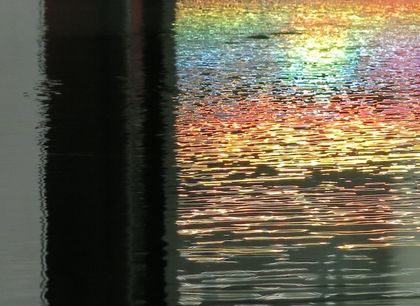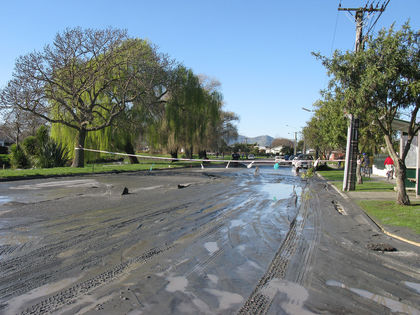What happens in a community after a sizeable calamity has struck and there is very little mainstream television media presence?
To get to this question I shall tell a tale.
July 2012 – a year and half after the worst of the Christchurch earthquakes. The New Zealand government, in an effort to keep up momentum, gives a chosen group a deadline to come up with a plan for a new city centre. The Christchurch Central Recovery Plan is to become known as the Blueprint.
These were extraordinary days. Eighty per cent of the centre of my home town was in the process of being demolished. At the heart of the destruction, in a central city building, teams of designers and engineers were in ‘lock down’, creating a new city centre. This gathering was contracted to produce a plan in 100 days. Many rumours were circulating about just how radical the plans were to be. But not a word had escaped. Media had been kept well away.
It must have been on about day 90 that I rang the Christchurch Earthquake Recovery Authority (CERA) communications team and asked if television footage had been recorded inside the lock up. The very thought was met with incredulity. ‘Of course not - it’s a lock up. Plans will be made public at the launch in a month’s time.’
Of course CERA communications is well used to arranging media moments, as they did weeks later when the Prime Minister, in front of a selected audience and a live band, unveiled the Blueprint. ‘But,’ I argued, ‘this is an historic time. Do you really intend that no archival footage be taken of this achievement? Won’t these 100 days become significant in years to come?’
I could hear the hesitation, ‘Oh – well - I’ll talk to someone and we’ll get back to you.’
They did, and the next day I was invited to spend half an hour inside the epicentre of our recovery. Groups of elated and exhausted engineers, designers and kindred disciplines were hunched over tables deep in conversation with each other. A sense of urgency and purpose really did make for some memorable footage.
Extraordinarily, to my knowledge, I now own the only footage from the time of the ‘lock up.’ I have been asked by other broadcasting interests for the footage. It seems that this has already become the valuable footage it was always destined to be. But why was I the only one to knock on the door? Why was this 100-day event not eagerly filmed by all the major television networks in New Zealand? Obviously, the Auckland-based networks were just not interested. Surely this would be of significant interest to the 341,000 who live in the city of Christchurch? To the half a million who live in province of Canterbury?
Those thoughts beg a bigger question. The question I started with.
We in Christchurch have been blessed with a local newspaper and over the last three years their journalists have been prolific, investigative and inquisitive – and thank God for them. We are also fortunate that a nightly current affairs programme from one of the Auckland-based networks has featured countless tales from Christchurch. But of course these have to rate for the larger Auckland audience. So populist tales about the little guy being mistreated by the Goliaths – the insurance companies or the Earthquake Commission – are featured again and again. There is a local television channel that enthusiastically records daily events in Christchurch, but they are seen by only a small percentage of households, their budget is tiny and their staff ill-resourced to handle the complexities of so many stories.
In New Zealand, state-funded television is broadcast from Auckland in the North Island. A third of our 4.5 million population lives there, over 1000 kilometres from Christchurch. Increasingly over the last 25 years, the two-thirds of New Zealanders who do not live in Auckland have been largely forgotten by our national broadcasters.
In 2012 a study by Media and Communication students at the University of Canterbury analysed who told what stories on prime time New Zealand television. Over a three month period they watched and categorised all publicly funded programmes, with the exception of news and current affairs, that were broadcast on any of the six national free to air channels. Over these three months Christchurch appeared on national screens on average for 33 minutes a week. Aucklanders saw themselves for 659 minutes – twenty times Christchurch’s lot. And this was after we had had an earthquake.[i]
We, in Christchurch, have long been used to watching the lives of others.
What’s more, any story shot in Christchurch for network television has to be of interest to an Auckland audience. In that sense, we in Christchurch are without the ability to tell our own stories for our own needs – and that is why the lock up was not recorded. Auckland audiences were just not interested. So how were the earthquakes recorded here when the quakes hit? How well were we resourced to speak to each other via television about our traumatised lives? What vehicles did we have?
For the first weeks – months even – Christchurch was covered head to toe with television crews parachuting in from other lands. The world’s media were here. And they, along with our very own squadrons from Auckland, were fascinating to observe in action.
At the time I was living in the heart of the city and recording events from the point of view of a freelance and unfunded documentary maker. With fallen buildings and unfolding stories all around I figured I didn’t need the accreditation pass hung around my neck. I chose to work alone.
I was learning first hand what veteran American news anchor Ted Koppel meant when he famously explained that it is not the task of mainstream media to be investigative – that is the domain of the fringe media. That sure was true of what happened here in Christchurch in those terrible first weeks. It does not seem to matter what the network, the stories by each were so often clones of each other – competing media were bussed together to the same events, all under the prescribed direction of governmental communication advisors.
But those days are well over now. These days the community of Christchurch is focused on rebuilding our city. Again the medium of television is by far our most effective resource when it comes to informing the people.
The statistics in Christchurch remain extraordinary. Around 91 per cent of homes were damaged,[ii] 17,000 houses uninhabitable,[iii] thousands of residents displaced. The heart of the city has been removed. The rebuild is said to be the second largest insured loss pay-out anywhere, anytime.[iv]
But in Christchurch there remains almost no vehicle on state-funded television for us to talk and debate with and for each other. We have no regular mainstream state-funded television outlet to speak specifically to local audiences.
Many would say that the New Zealand government has chosen a top-down approach to lead Christchurch’s recovery. One Minister of the Crown has been given extraordinary powers by New Zealand’s right-wing government to lead very much from the front. Minister Brownlee is famous for his hands on approach. CERA, his government department, likes to hang on to the notion that the Christchurch City Council’s public participation scheme Share an Idea has been the underlying motivation for decisions that shape the city. But many observe that the 106,000 ideas the community supplied are able to prop up or deny any proposed direction. The city partially retaining its one-way street system would be an example. Is this what the people requested in the Council’s survey?
Many residents protest that we are spectators on the sideline, unable to find a forum for public debate. How many of the peoples’ wishes about the future of the abandoned land in the eastern suburbs are likely to be realised? What debate is being heard? A very up-market central city swimming pool complex has been planned. What voice is the public having in this far-reaching decision? What do we know of our own psychological wellbeing? Are our people facing post-traumatic stress that has not been seen in New Zealand in previous times? How are our children faring? Our old people?
In some ways the lack of strong and functional mainstream television media in Christchurch must be a godsend to those who are making decisions. Their subjects are placid and have long learned to acquiesce to being voiceless. But is this really how a vital community best functions?
I am in my sixties, old enough to remember very different times. Twenty years ago publicly funded broadcasters TVNZ and the NZBC before them had over 300 staffers based in Christchurch. Each day a team of around 40 put together a five night a week, half hour show. It was made by us, about us and for us. From the middle of the city, journalists and camera crews produced daily in-depth stories about all manner of subjects. Interestingly most of the reporters were mature, intelligent and respected storytellers. Often not trained journalists, they were a far cry from today’s fresh young faces. Imagine if we had had this resource over the last three years! For on every corner in this town is a story that would make headlines for weeks in any other city.
I want to live in a city that, right now, is alive with debate. It’s ideas time in Christchurch and shall be for a long time to come. For the people to personally buy into a sense of our own recovery, we need to feel involved. A half hour breakout every evening on state funded television would help all of us enormously. Because only when we can tell our own stories in our own community will we be able to sense our own wellbeing.
That sense is foreign to so many of us here today.
---
Gerard Smyth began his screen career in 1969 as a cameraman for the state broadcaster NZBC. Since turning director 30 years ago, he has directed over 80 documentaries on everything from the disabled to the arts. Qantas-nominated for his 2008 feature documentary on cinematographer Alun Bollinger, Smyth was awarded ‘Best Director, Documentary’ at the NZ Television Awards for his 2011 When a City Falls, an acclaimed account of the quakes in his hometown of Christchurch.
This essay is drawn from the book Once in a Lifetime: City-building after Disaster in Christchurch. The book's Auckland launch will be held at Q Theatre from 6pm on September 17. A discussion will be held in Wellington the next day -- details to follow.

